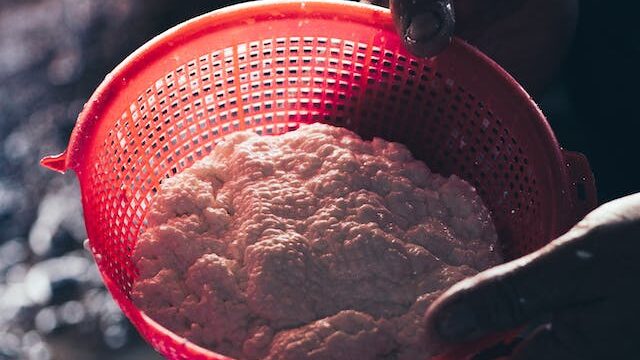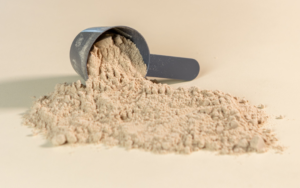Whey protein has been a staple in the fitness community for years, known for its potent muscle-building properties. But what exactly is whey protein, and what makes it so special? Let’s dive into the world of whey protein ingredients and discover its benefits, types, and more.
Table of Contents
Key Takeaways:
- Whey protein is a powerhouse of essential amino acids.
- It plays a pivotal role in muscle recovery and growth.
- Understanding its ingredients can help in making informed dietary choices.
Understanding Whey Protein
Whey protein is a byproduct of the cheese-making process. It’s a complete protein, meaning it contains all nine essential amino acids. These amino acids are crucial for muscle repair and growth. But what makes whey protein stand out from other protein sources?
Primary Ingredients in Whey Protein
- Alpha-lactalbumin: This is a major component of whey protein and is known for its high tryptophan content. Tryptophan is an essential amino acid that plays a role in the production of serotonin, a neurotransmitter that regulates mood. Learn more about α-lactalbumin.
- Beta-lactoglobulin: This is the most abundant protein in whey. It’s rich in essential and branched-chain amino acids, which are crucial for muscle synthesis. Dive deeper into β-lactoglobulin.
- Immunoglobulins: These are antibodies that play a role in the immune system. They help the body fight off viruses and bacteria.
- Bovine Serum Albumin: This is a major plasma protein that carries hormones, drugs, and other substances through the blood.
- Lactoferrin: This protein has antibacterial properties and plays a role in iron absorption in the intestines.
Benefits of Whey Protein Ingredients
Whey protein is not just about muscle growth; its ingredients offer a plethora of health benefits:
- Muscle Recovery: The rich amino acid profile aids in faster muscle recovery post workouts.
- Weight Management: Whey protein can make you feel full, reducing the urge to eat and assisting in weight management.
- Antioxidant Support: It helps increase the levels of glutathione, a major antioxidant in the body.
- Lowers Cholesterol: Regular consumption can lead to a significant decrease in total cholesterol and LDL cholesterol.
How is Whey Protein Made?
The production of whey protein involves several steps:
- Cheese Production: When milk is coagulated during cheese production, whey is the liquid that’s left over.
- Filtering: The liquid whey is then filtered to remove fats and carbohydrates.
- Drying: The filtered liquid is dried to produce whey protein concentrate.

For those who are lactose intolerant or looking for a purer form of protein, whey protein isolate is produced. It undergoes further processing to remove almost all the fat and lactose.
Choosing the Right Whey Protein
When shopping for whey protein, it’s essential to understand the different types available:
- Whey Protein Concentrates (WPC): Contains some fat and lactose. Protein percentage can vary from 30% to 90%.
- Whey Protein Isolates (WPI): Over 90% protein by weight and contains minimal fat and lactose.
- Whey Protein Hydrolysates (WPH): Pre-digested and partially hydrolyzed for easier absorption.
There are many other protein powder sources, in this article well only focus on Whey Protein.
Table: Comparison of Whey Protein Types
| Type | Protein Content | Fat Content | Lactose Content |
|---|---|---|---|
| WPC | 30% – 90% | Moderate | Moderate |
| WPI | >90% | Low | Low |
| WPH | Varies | Varies | Varies |
Incorporating Whey Protein in Diet
Whey protein is versatile and can be incorporated into various meals:
- Smoothies: Blend with fruits, vegetables, and milk or water.
- Oatmeal: Mix in your morning oats for a protein boost.
- Baking: Add to pancakes, muffins, or bread recipes.
Table: Simple Whey Protein Recipes
| Recipe Name | Ingredients | Preparation |
|---|---|---|
| Protein Pancakes | Whey protein, oats, banana, egg | Blend ingredients and cook on a skillet |
| Berry Protein Smoothie | Whey protein, mixed berries, almond milk | Blend until smooth |
| Protein Muffins | Whey protein, almond flour, eggs, baking powder | Mix and bake at 350°F for 20 minutes |
Safety and Precautions
While whey protein is safe for most people, it’s essential to:
- Check for Allergies: Some individuals might be allergic to ingredients in whey protein.
- Monitor Intake: Excessive protein intake can strain the kidneys.
- Consult a Doctor: Especially if you have liver or kidney problems.
The Science Behind Whey Protein Ingredients
Whey protein is more than just a popular supplement; it’s backed by science. The unique composition of whey protein makes it a preferred choice for athletes and fitness enthusiasts.
Amino Acid Profile
Whey protein boasts a rich amino acid profile, which is the building block of proteins. These amino acids are essential for various bodily functions, including muscle synthesis and repair.
Table: Amino Acid Composition in Whey Protein
| Amino Acid | Percentage in Whey Protein |
|---|---|
| Leucine | 10% |
| Isoleucine | 6% |
| Valine | 5% |
| Tryptophan | 1.5% |
| Methionine | 2% |
Bioavailability of Whey Protein
The term “bioavailability” refers to the proportion of a nutrient that enters the circulation when introduced into the body and is made available for use. Whey protein has a high bioavailability, meaning it’s efficiently absorbed and utilized by the body.
Whey Protein vs. Other Protein Sources
While whey protein is highly regarded, how does it compare to other protein sources like casein or soy?
- Digestion Rate: Whey protein is digested faster than casein but slower than soy.
- Amino Acid Profile: Whey has a superior amino acid profile, especially in branched-chain amino acids.
- Taste and Texture: Many users prefer the taste and texture of whey over other protein sources.
Table: Comparison of Protein Sources
| Protein Source | Digestion Rate | BCAA Content | Taste |
|---|---|---|---|
| Whey | Fast | High | Good |
| Casein | Slow | Moderate | Fair |
| Soy | Moderate | Low | Varies |
Environmental Impact of Whey Production
With the increasing demand for whey protein, it’s essential to consider its environmental impact. The dairy industry, from which whey is derived, has a significant carbon footprint. However, many manufacturers are now adopting sustainable practices to reduce their environmental impact.

FAQs on Whey Protein Ingredients
- Is whey protein suitable for vegetarians?
Yes, whey protein is derived from milk, making it suitable for vegetarians but not for vegans. - Can whey protein cause allergies?
Some individuals might be allergic to lactose or other components in whey protein. It’s essential to check the ingredients and consult a doctor if unsure. - How much whey protein should I consume daily?
The recommended daily intake varies based on individual needs, activity levels, and dietary preferences. It’s best to consult a nutritionist for personalized advice.



